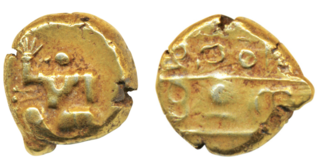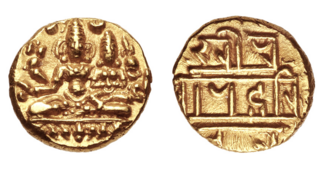Foundation and early history

The Sangama dynasty was founded by Harihara I and Bukka. Their father had been taken prisoner in 1327 by Muhammad bin Tughluq. They founded Vijayanagara in 1336. [2]
| Vijayanagara Empire |
|---|
| Ruling dynasties |
The Sangama dynasty was a dynasty of the Vijayanagara Empire founded in the 14th century by two brothers: Harihara I (also called Vira Harihara or Hakka Raya) and Bukka Raya I. [1] They were the sons of Bhavana Sangama, [2] of Yadava lineage. [3] [4] [5]

The Sangama dynasty was founded by Harihara I and Bukka. Their father had been taken prisoner in 1327 by Muhammad bin Tughluq. They founded Vijayanagara in 1336. [2]
Bukka's successor, Harihara II, continued Bukka's campaign through southern India and managed to take control of coastal Andhra between Nellore and Kalinga and conquer the Addanki and Srisailam areas as well as most of the territory between the peninsula to the south of the Krishna River. Harihara II also managed to conquer many Indian ports such as that of Goa, Chaul, and Dabhol.
After Harihara II died the throne was in conflict between Virupaksha Raya, Bukka Raya II, and Deva Raya of which Deva Raya eventually would come out as victor. During his reign, Deva Raya managed to successfully control the vast amount of territory in the empire. The kings after Deva Raya on the other hand did not manage to do anything significant at all for the kingdom. This was until Deva Raya II, who would bring about the golden age of the Sangama Dynasty. Under Deva Raya II's rule, the empire would succeed in completely conquering southern India such as conquering Kondavidu, defeating the ruler of Quilon as well as other chieftains, extending the empire from Odisha to Malabar and from Ceylon to Gulbarga, and also taking over a lot of the major Indian ports. However after Deva Raya II, his incompetent successors would eventually lead to the destruction of the dynasty with the Bahamani Kingdoms continually taking over much of the Vijayanaga territory. Virupaksha Raya II was the last emperor of the dynasty.

The Vijayanagara Empire was a medieval Hindu empire that ruled much of southern India. It was established in 1336 by the brothers Harihara I and Bukka Raya I of the Sangama dynasty, members of a pastoralist Gadariya community that claimed Kuruba lineage.

Vidyaranya, usually identified with Mādhavācārya, was the jagadguru of the Sringeri Sharada Peetham from ca. 1374–1380 until 1386 - according to tradition, after ordination at an old age, he took the name of Vidyaranya, and became the Jagadguru of this Matha at Sringeri.

BukkaRaya I was an emperor of the Vijayanagara Empire from the Sangama Dynasty. He was a son of Bhavana Sangama, the chieftain of a cowherd pastoralist community, Yadava people|Golla]] descent. The first Bahmani-Vijayanagar War was occurred during the reign of Bukka Raya I, in which he was besieged, and sued for peace.

Harihara II was an Emperor of the Vijayanagara Empire from the Sangama Dynasty. He patronised the Kannada poet Madhura, a Jaina. An important work on the Vedas was completed during his time. He earned the titles Vaidikamarga Sthapanacharya and Vedamarga Pravartaka.

Deva Raya I was a king of the Vijayanagara Empire. After Harihara II died, there was a dispute between his sons over succession, in which Deva Raya I eventually emerged victor. He was a very capable ruler noted for his military exploits and his support to irrigation works in his kingdom. He modernized the Vijayanagara army by improving the cavalry, employed skilled archers of the Turkic clans and raised the fighting capacity of his bowmen and imported horses from Arabia and Persia.
Ramachandra Raya was an emperor of the Vijayanagara Empire from the Sangama Dynasty.
Veera Vijaya Bukka Raya was an emperor of the Vijayanagara Empire from the Sangama Dynasty.
Virupaksha Raya was an emperor of the Vijayanagara Empire. With the death of Harihara II in 1404, the throne for the Vijayanagara Empire was disputed amongst his sons: Deva Raya I, Bukka Raya II, and Virupaksha Raya. Virupaksha Raya would only rule for a few months before being murdered by his sons and then being succeeded by his brother Bukka Raya II. Bukka Raya II then ruled for two years before he himself was succeeded by his brother Deva Raya I.
Mallikarjuna Raya was an Emperor of Vijayanagara from the Sangama Dynasty.

Virupaksha Raya II (1465–1485) was an Emperor of Vijayanagara from the Sangama dynasty.
The Saluva dynasty was the second dynasty to rule the Vijayanagara Empire and was created by the Saluvas, who by historical tradition were natives of the Kalyani region of northern Karnataka in modern India. The Gorantla inscription traces their origins to this region from the time of the Western Chalukyas and Kalachuris of Karnataka. The term "Saluva" is known to lexicographers as "hawk" used in hunting. They later spread into the east coast of modern Andhra Pradesh, perhaps by migration or during the Vijayanagara conquests during the 14th century.
Bukka Raya II was an emperor of the Vijayanagara Empire from the Sangama Dynasty.

Harihara I, also called Hakka and Vira Harihara I, was the founder of the Vijayanagara Empire, which he ruled from 1336 to 1356 CE. He and his successors formed the Sangama dynasty, the first of four dynasties to rule the empire. He was the eldest son of Bhavana Sangama, the chieftain of a cowherd pastoralist community, who claimed Yadava descent.
The origin of the Vijayanagara Empire is a controversial topic in South Indian history, with regard to the linguistic affiliation of the founding dynasty, the Sangama family. The Vijayanagara Empire rose to power in southern India in the 14th century CE. Over the past decades historians have expressed differing opinions on whether the empire's founders, Harihara I and Bukka I, were of Kannada people or Telugu origin. There are various opinions about role of the Vidyaranya, the Hindu saint and guru of Harihara I and Bukka I in the founding of the Vijayanagara empire.
Chamarajara Wodeyar II was the fourth raja of the Kingdom of Mysore from 1478 until 1513.
Bhavana Sangama or simply Sangama was the father of the brothers Harihara I and Bukka Raya I, the founders of the Vijayanagara Empire.

The War of the Goldsmith's Daughter or the Bahmani–Vijayanagar War of 1406 was a significant conflict between the Bahmani Sultanate and the Vijayanagar Empire, the two primary powers in the Deccan region of thirteenth and fourteenth century India, occurring in 1406. Led by Tajuddin Firuz Shah, the Bahmani forces, supported by Velama chiefs and the Reddis, launched multiple attacks on the Vijayanagar empire under the rule of Deva Raya I. Despite initial resistance, Deva Raya faced heavy casualties, ultimately compelling him to accept the terms imposed by the Bahmanis. As a result, the Vijayanagar ruler pursued peace, resulting in victory for the Bahmanis.